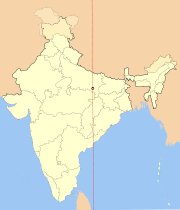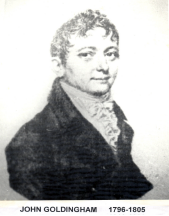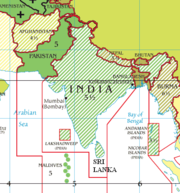Indian Standard Time
2007 Schools Wikipedia Selection. Related subjects: Geography of Asia
Indian Standard Time (IST) is the time observed throughout India, with a time offset of UTC+5:30. India does not observe daylight saving time (DST) or other seasonal adjustments, although DST was used briefly during the Sino–Indian War of 1962, and the Indo–Pakistani Wars of 1965 and of 1971. In military and aviation time, IST is designated E* = Echo*.
Indian Standard Time is calculated on the basis of 82.5 °E longitude which is just west of the town of Mirzapur, near Allahabad in the state of Uttar Pradesh. The longitude difference between Mirzapur and the United Kingdom's Royal Observatory at Greenwich translates to an exact time difference of 5 hours and 30 minutes. Local time is calculated from a clock tower at the Allahabad Observatory () though the official time-keeping devices are entrusted to the National Physical Laboratory, located in New Delhi.
History
One of the earliest descriptions of standard time in India appeared in the 4th century CE astronomical treatise Surya Siddhanta. Postulating a spherical earth, the book defined the prime meridian, or zero longitude, as passing through Avanti, the ancient name for the historic city of Ujjain (), and Rohitaka, the ancient name for Rohtak (), a city near the historic battle-field of Kurukshetra.
Situated upon the line which passes through the haunt of the demons (equator and 76° E) and the mountain which is the seat of the gods (the North Pole), are Rohitaka and Avanti ...
The sidereal day of ancient Indian astronomy began at sunrise at the prime meridian of Ujjain, and was divided into smaller time units in the following manner:
Time that is measurable is that which is in common use, beginning with the prāṇa (or, the time span of one breath). The pala contains six prāṇas. The ghalikā is 60 palas, and the nakṣatra ahórātra, or sidereal day, contains 60 ghalikās. A nakṣatra māsa, or sidereal month, consists of 30 sidereal days.
Taking a sidereal day to be 24 hours, it is easily computed that the smallest time unit, prāṇa, or one respiratory cycle, equals 4 seconds, a value consistent with the normal breathing frequency of 15 breaths/min used in modern medical research. The Surya Siddhanta also described a method of converting the local time of an observer to the standard time of Ujjain. However, despite these early advances, standard time was not widely used outside of astronomy. For most of India's history, ruling kingdoms kept their own local time, typically using the Hindu calendar in both lunar and solar units. For example, the Jantar Mantar observatory built by Maharaja Sawai Jai Singh in Jaipur in 1733 contains large sundials, up to 90 ft. high, which were used to accurately determine the local time.
In 1792, the British East India Company established the Madras Observatory in Chennai (then Madras), largely due to the efforts of the British sailor–astronomer Michael Topping. In 1802, John Goldingham, appointed as the first official astronomer of the Company in India, established the longitude of Madras () as 5 hours and 30 minutes ahead of Greenwich Mean Time as the local standard time. This marked the first ever use of the current time zone, and departure from the earlier standard of the day beginning at sunrise; now it started at midnight. The clock in the observatory was attached to a gun that was fired at 8 p.m. daily to announce that "all was well" with IST. Time-keeping support for shipping activities in Bombay Harbour was provided by the Colaba Observatory in Bombay, which was established in 1826.
Most of the towns in India retained their own local time until a few years after the introduction of the railways in the 1850s, when the need for a unified time–zone became apparent. As headquarters of the two largest Presidencies of British India, local time in Mumbai (then Bombay) and Kolkata (then Calcutta) assumed special importance, that was gradually adopted by the nearby provinces and princely states. In the 19th century, clocks at various locations were kept in synchronisation through telegraphic means – for example the railways synchronised their clocks thorough a time signal which was sent from the head office or the regional headquarters at a specified time every day.
In 1884, the International Meridian Conference in Washington, D.C., set up uniform time zones across the world. It was decided that India would have two time zones, with Kolkata using the 90th east meridian and Bombay the 75th east meridian. Calcutta time was set at 5 hours, 30 minutes, and 21 seconds in advance of GMT, while Bombay time was 4 hours, 51 minutes ahead of GMT. By the late 1880s, many railway companies began to use the Madras time (known as " Railway time") as an intermediate time between the two zones. Another time zone, Port Blair mean time, was established at Port Blair, the capital of the Andaman and Nicobar Islands in the Bay of Bengal. The Port Blair mean time was set to 49 minutes and 51 seconds ahead of Madras time.
British India did not officially adopt the standard time zones until 1905, when the meridian passing east of Allahabad at 82.5 degrees east longitude was picked as the central meridian for India, corresponding to a single time zone for the country. This came into force on January 1, 1906, and also applied to Sri Lanka (then Ceylon). However Calcutta time was officially maintained as a separate time zone until 1948.
In 1925, time synchronisation began to be relayed through omnibus telephone systems and control circuits to organisations that needed to know the precise time. This continued until the 1940s, when time signals began to be broadcast using the radio by the government.
After independence in 1947, the Indian government established IST as the official time for the whole country, although Kolkata and Mumbai retained their own local time for a few more years. The Central observatory was moved from Chennai to a location near Mirzapur so that it would be as close to UTC +5:30 as possible.
During the Sino–Indian War of 1962, and the Indo–Pakistani Wars of 1965 and 1971, daylight saving was briefly used to reduce civilian energy consumption.
Problems
A single, large time zone has been shown to cost more, and requires rescheduling of events to make them compatible with the rest of the zone or with the day's cycle. The country's east–west distance of more than 2,000 km (1,200 mi) covers over 28 degrees of longitude, resulting in the sun rising and setting almost two hours earlier on India's eastern border than in the Rann of Kutch in the far west. Inhabitants of the north–eastern states have long demanded a separate time zone to advance their clocks with the early sunrise and avoid the extra consumption of energy after daylight hours.
In the late 1980s, a team of researchers proposed separating the country into two or three time zones to conserve energy. The binary system that they suggested involved a return to British–era time zones; the recommendations were not adopted.
In 2001, the government established a four–member committee under the Department of Science and Technology to examine the need for multiple time zones and daylight saving. The findings of the committee, which were presented to Parliament in 2004 by the Minister for Science and Technology, Kapil Sibal, did not recommend changes to the unified system stating that "the prime meridian was chosen with reference to a central station, and that the expanse of the Indian State was not large."
Though the government has consistently refused to split the country into multiple time zones, provisions in various Indian labour laws such as the Plantations Labour Act, 1951 do allow the Central and State governments to define and set the local time for a particular industrial area.
Time signals
In India, official time signals are generated by the Time and Frequency Standards Laboratory at the National Physical Laboratory in New Delhi, for both commercial and official use. The signals are based on atomic clocks and are synchronised with the worldwide system of clocks that support the Universal Coordinated Time.
Features of the Time and Frequency Standards Laboratory include :
- Four caesium and rubidium atomic clocks;
- High frequency broadcast service operating at 10 MHz under call sign ATA to synchronise the user clock within a millisecond;
- Indian National Satellite System satellite–based standard time and frequency broadcast service, which offers IST correct to ±10 microsecond and frequency calibration of up to
 ; and
; and - Time and frequency calibrations are made with the help of pico– and nanoseconds time interval frequency counters and phase recorders.
To communicate the exact time to the people, the exact time is broadcast over the state–owned All India Radio and Doordarshan television network. Telephone companies have dedicated phone numbers connected to mirror timeservers that also relay the precise time. Another increasingly popular means of obtaining the time is through Global Positioning System (GPS) receivers.


